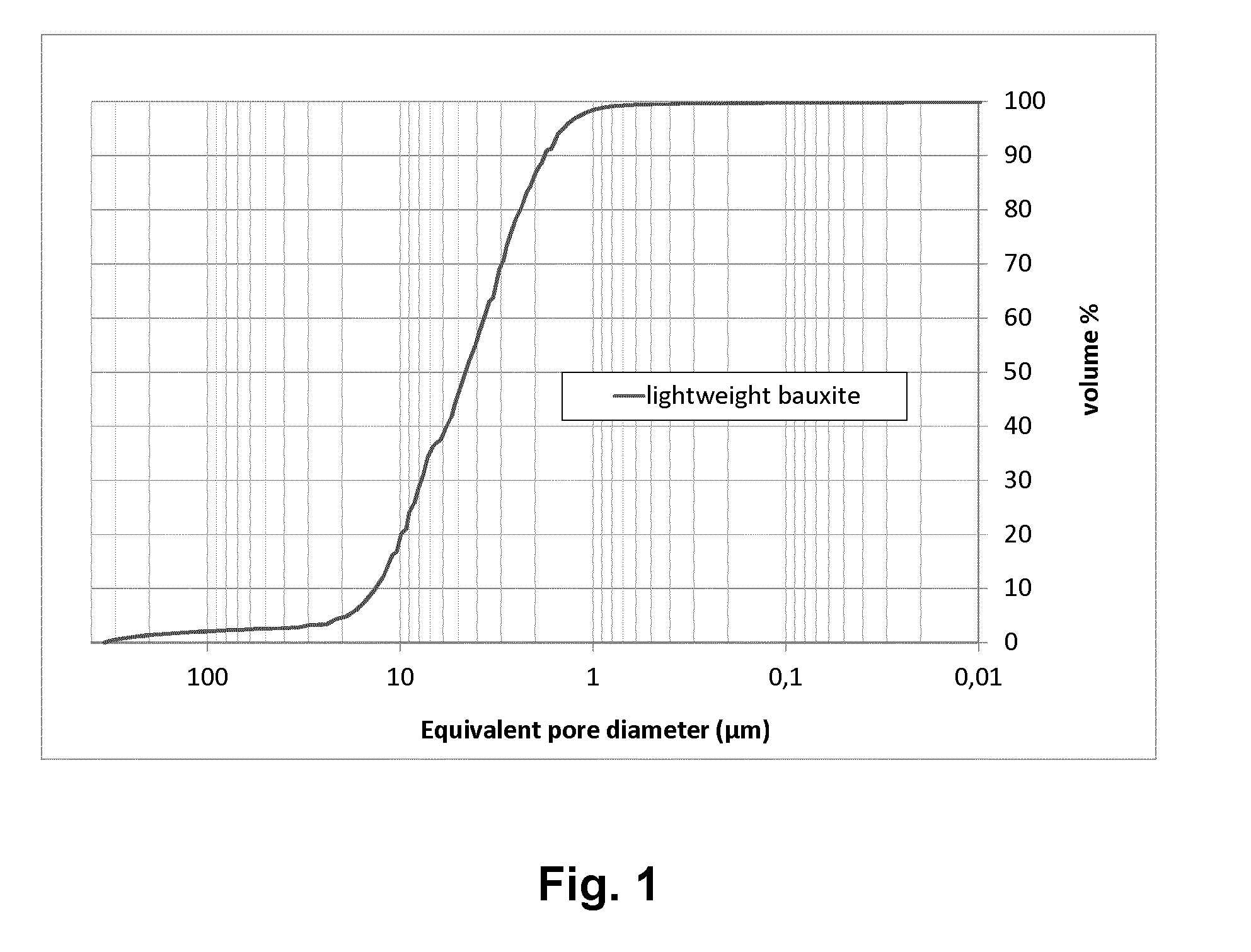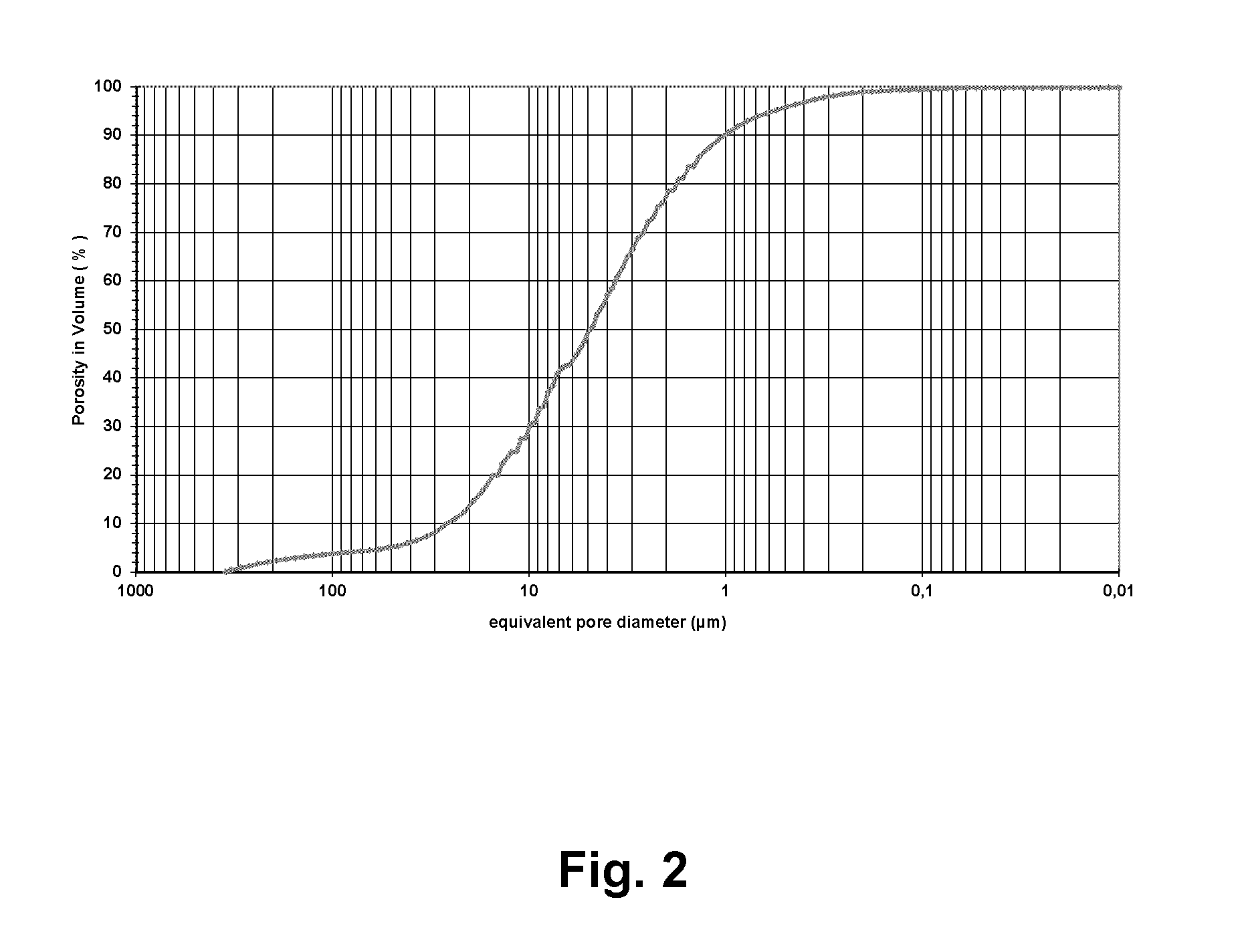Silico-aluminate containing aggregates for production of monolithic refractory compositions, their method of production and their use
a monolithic refractory composition and aggregate technology, applied in the field of methods, can solve the problems of reducing the refractoriness, limiting the use of low temperature applications, and affecting the physical properties and infiltration resistance of slag and/or molten metal,
- Summary
- Abstract
- Description
- Claims
- Application Information
AI Technical Summary
Benefits of technology
Problems solved by technology
Method used
Image
Examples
example 1
[0066]Porous alumina containing aggregates for use in monolithic refractory compositions according to the present invention were prepared. The porous alumina aggregates were prepared by mixing together the components as shown in Table I.
TABLE IComponentAmountwt-%size (d50 / diam.)LOIRotary720 kg7225μm0 to0.15%kiln0.09 mmbauxitegradeIMP IIAIndal140 kg144.5μm99.5% 34.5%alumina45 μmhydrateRPF 14“Indian140 kg1445 to 50μm99.5% 99.9%sugar”120 μm
[0067]The bauxite used had the following chemical composition: SiO2: 5.8 wt.-%; Al2O3: 87.0 wt.-%; TiO2: 3.7 wt.-%; Fe2O3: 1.9 wt.-%. “LOI” in Table I stands for “loss on ignition”.
[0068]The porous alumina aggregate was obtained as follows. Rotary kiln bauxite grade IMP IIA—170 mesh (72 wt.-%), Indal Alumina hydrate RPF 14 (14 wt.-%) and ultrafine sugar (14 wt.-%) were mixed together for 3 minutes at low speed. Special care was taken in that no formation of sugar lumps had taken place. Sugar lumps form when the sugar is in storage for a long time or ...
example 2
[0073]Porous silico-aluminate aggregates were prepared for use in monolithic refractory compositions according to the present invention were prepared. The porous alumina aggregates were prepared by mixing together the components as shown in Table II:
TABLE IIComponentAmountwt-%size (d50 / diam.)LOIGyana rasc720 kg72μmmm0.15%bauxitepulverisedAluminium140 kg141.2μmmm34.5%hydroxideMartinOL-107Ultrafine140 kg1420μmmm99.9%icingsugar PS
[0074]At the initial step of pelletisation, around 40% of the mixture was placed in a pan pelletiser with a capacity of approximatively 50 kg. Once the pan pelletiser was activated, water was slowly added to the mixture. Sequentially small amounts of powder were added to the mixer, followed by a proportional amount of water (in total 8 wt. % based on the whole weight of the particulate mixture). This stage was carried out entirely at room temperature. At the end of this process, small round pellets having a size in the range of 0.1 mm to 30 mm were formed. Nex...
PUM
| Property | Measurement | Unit |
|---|---|---|
| Temperature | aaaaa | aaaaa |
| Fraction | aaaaa | aaaaa |
| Fraction | aaaaa | aaaaa |
Abstract
Description
Claims
Application Information
 Login to View More
Login to View More - R&D
- Intellectual Property
- Life Sciences
- Materials
- Tech Scout
- Unparalleled Data Quality
- Higher Quality Content
- 60% Fewer Hallucinations
Browse by: Latest US Patents, China's latest patents, Technical Efficacy Thesaurus, Application Domain, Technology Topic, Popular Technical Reports.
© 2025 PatSnap. All rights reserved.Legal|Privacy policy|Modern Slavery Act Transparency Statement|Sitemap|About US| Contact US: help@patsnap.com


